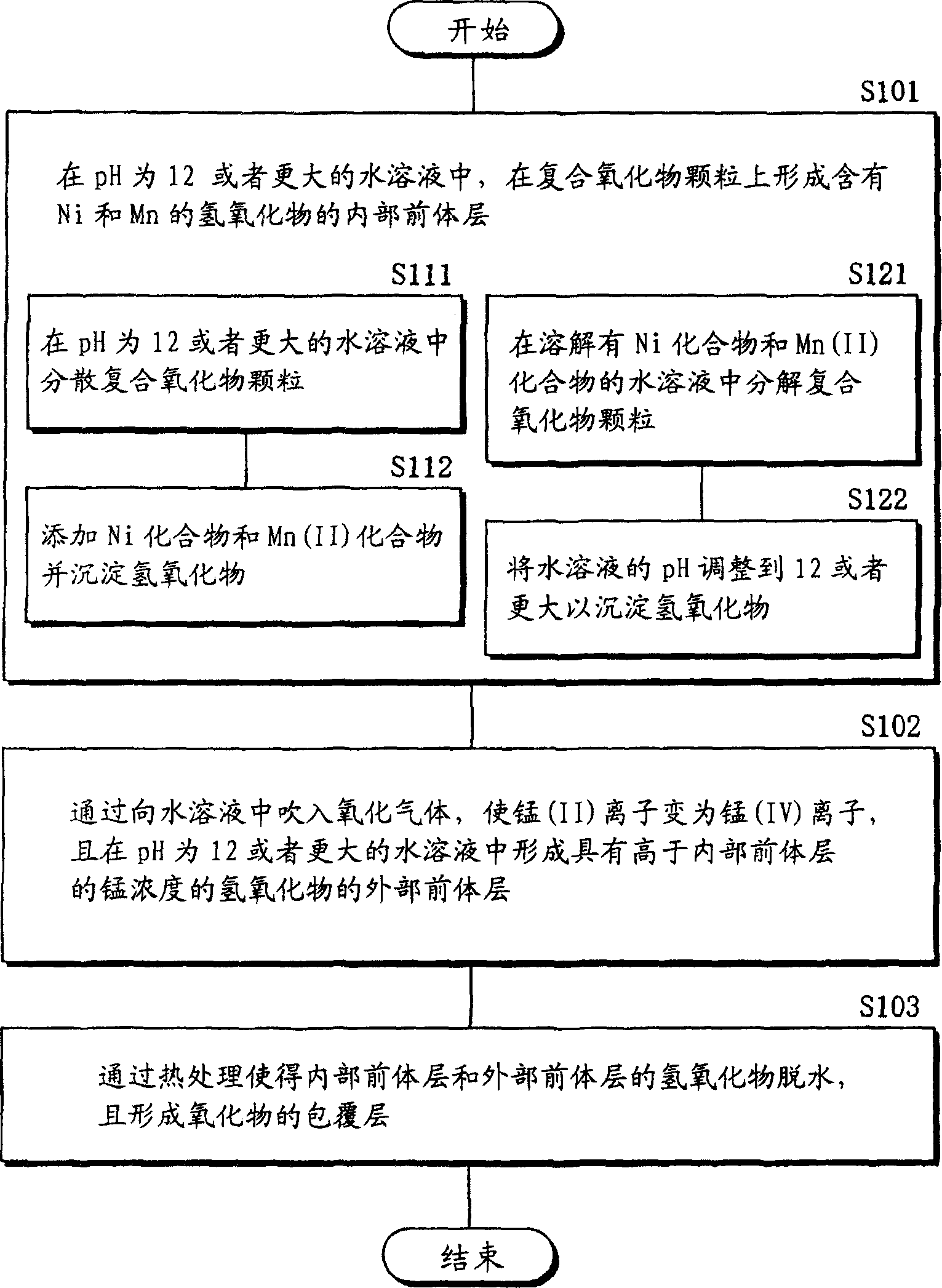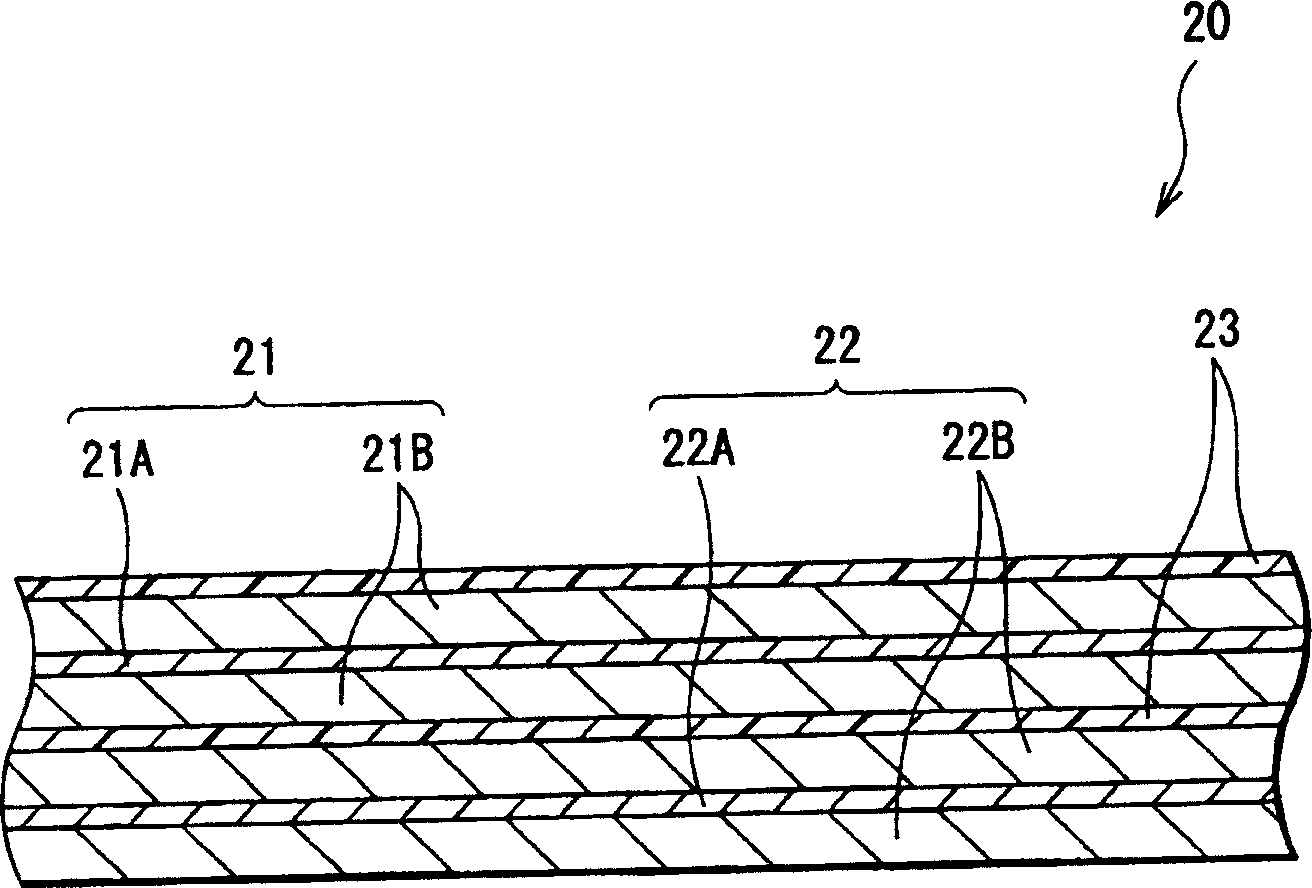Cathode active material, method of manufacturing it, cathode, and battery
A positive active material and positive electrode technology, applied in the direction of active material electrodes, secondary batteries, battery electrodes, etc., can solve the problem of characteristic degradation, achieve high capacity and high voltage, improve chemical stability, improve high temperature characteristics or cycle characteristics Effect
- Summary
- Abstract
- Description
- Claims
- Application Information
AI Technical Summary
Problems solved by technology
Method used
Image
Examples
Embodiment 1-1 and 1-2
[0129] The positive electrode active material is formed as follows. First, 38.1 parts by weight of lithium carbonate (Li 2 CO 3 ), 113.0 parts by weight of cobalt carbonate (CoCO 3 ), 23.4 parts by weight of aluminum hydroxide (Al(OH) 3 ) And 16.9 parts by weight of magnesium carbonate (MgCO 3 ), and crushed with a ball mill at the same time. After the resultant was calcined in air at 650 degrees Celsius for 5 hours, the resultant was sintered in air at 950 degrees Celsius for 20 hours to form composite oxide particles. The average composition of the formed composite oxide particles was checked by ICP spectrometry. The result is Li 1.03 Co 0.95 Al 0.03 Mg 0.02 O 2.02 . Next, the composite oxide particles are crushed, and the particle size is adjusted. The average particle size measured by the laser scattering method was 11 μm.
[0130] Next, 20 parts by weight of the composite oxide particles were stirred and dispersed in 300 parts by weight of a 2N lithium hydroxide aqueous solut...
Embodiment 2-1 to 2-4
[0141] Except for the change in the average composition of the composite oxide particles, a positive electrode active material and a secondary battery were manufactured in the same manner as in Example 1-1. In Example 2-1, except that 38.1 parts by weight of lithium carbonate, 116.5 parts by weight of cobalt carbonate, 7.8 parts by weight of aluminum hydroxide, and 8.4 parts by weight of magnesium carbonate were mixed, the same as in Example 1-1 was used. Way to form composite oxide particles. When the average composition was tested in the same manner as in Example 1-1, the result was Li 1.03 Co 0.98 Al 0.01 Mg 0.01 O 2.02 .
[0142] In Example 2-2, in addition to mixing 38.1 parts by weight of lithium carbonate and 116.5 parts by weight of cobalt carbonate, and the resultant was added and mixed by adding 45.6 parts by weight of titanium ethoxide ((C 2 H 5 O) 4 The Ti) was dissolved in the solution obtained in absolute ethanol, and composite oxide particles were formed in the same...
Embodiment 3-1 to 3-3
[0149] Except that the method of forming the coating layer was changed, the positive electrode active material and the secondary battery were manufactured in the same manner as in Example 2-1. In Example 3-1, except that 3.20 parts by weight of nickel nitrate and 3.30 parts by weight of manganese nitrate were mixed, and the resultant was added to pure water to obtain 20 parts by weight of an aqueous solution, and the entire 20 parts by weight of the aqueous solution was mixed in The positive electrode active material was formed in the same manner as in Example 2-1 except that it was added to the lithium hydroxide aqueous solution in which the composite oxide particles were dispersed within one hour. That is, the addition amount of nickel nitrate and manganese nitrate was twice that of Example 2-1.
[0150] In Example 3-2, in addition to 0.86 parts by weight of aluminum nitrate (Al(NO 3 ) 3 ·9H 2 O) A commercially available reagent was added to 3.20 parts by weight of nickel nitrat...
PUM
| Property | Measurement | Unit |
|---|---|---|
| particle size | aaaaa | aaaaa |
| particle size | aaaaa | aaaaa |
| particle size | aaaaa | aaaaa |
Abstract
Description
Claims
Application Information
 Login to View More
Login to View More - R&D
- Intellectual Property
- Life Sciences
- Materials
- Tech Scout
- Unparalleled Data Quality
- Higher Quality Content
- 60% Fewer Hallucinations
Browse by: Latest US Patents, China's latest patents, Technical Efficacy Thesaurus, Application Domain, Technology Topic, Popular Technical Reports.
© 2025 PatSnap. All rights reserved.Legal|Privacy policy|Modern Slavery Act Transparency Statement|Sitemap|About US| Contact US: help@patsnap.com



